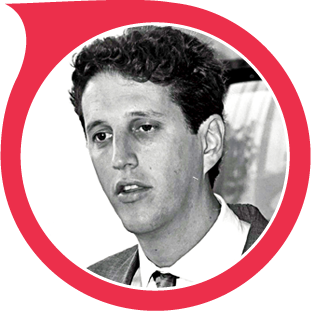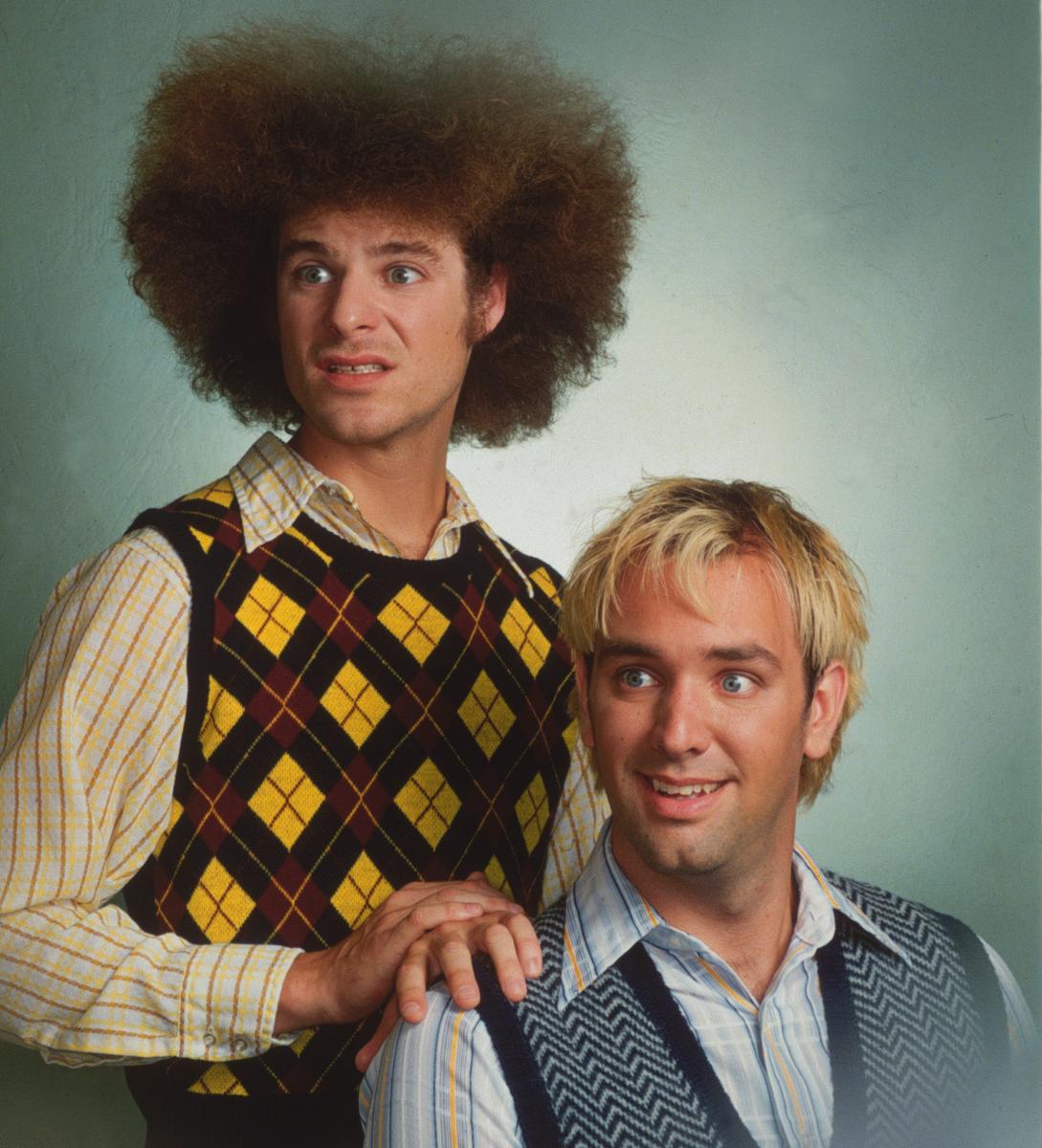
Trey Parker: Matt and I were at the University of Colorado at Boulder [in 1992]. When you’re in the film school, you’re working on someone’s film every weekend, so you’re spending your weekends on set. Matt and I would always end up either running cameras or running sound or something. Shoots are so f--king boring, and we would just sit there doing voices for each other—that’s where it actually started. We would always talk like these little kids and make each other laugh. So we had a year of doing little skits with the voices before we shot anything. The film department showed student films at the end of the semester. I was like, “There should be something Christmassy,” because these screenings were a few days before Christmas. I had done one even before that, called American History, with construction paper cutouts, and I got a student award for it. So Matt and I just did this little Jesus and Frosty thing.
“Jesus vs. Frosty,” a.k.a. the first “Spirit of Christmas,” had many elements that would later define South Park—foulmouthed, crudely animated Colorado kids who become embroiled in a satirical, absurd battle with outside forces.
Parker: [The audience reaction] was huge. It was just the fact that there were little-kid voices and cute animation and that they were screaming, “F---!” People hadn’t really seen anything like that before. It was mostly college kids so we knew our audience. At the time, we were just trying to do something that all our friends and college buddies would think was funny.
After college, Parker and Stone moved to L.A. in 1993 and met Fox exec Brian Graden at a screening of their indie film Cannibal! The Musical. The trio began collaborating on various projects and they showed him “Jesus vs. Frosty.”
Parker: Brian was like, “Show me everything you’ve done,” and we’re like, “Well, here’s this cartoon we made.” Brian totally loved it, and he’s like, “Can I send [this as] a Christmas card to everyone?” So he sent it to a production house and copied it a hundred times onto VHS tapes we’re just like, “Oh, that’s so cool.” He sent it to his friends. They loved that so much that the next year Brian said, “Can you make another one?”

Producer Brian Graden: There was no calculation that millions of people would see this and then we’d get a TV series. I wanted to do something cool for the Christmas card, and those guys are geniuses. We’d first seen their movie about cannibalism [Cannibal! The Musical], the Alfred Packer movie. They way they used pauses and their rhythms of comedy were so observational and genius. That was the first thing we saw, and [we] just got to know them, and they would do various projects. We did a kids’ pilot, if you can believe it, for Fox’s sister network. We had started developing South Park based on those characters before [the second video] was made.
Parker: He gave us, like, $2,000. We were so stoked. It was all single-cel animation, so the damn thing took a week of no sleep to make five minutes’ worth. We had talked about if it could ever be a show, and that’s why at the very beginning of “The Spirit of Christmas” we put the sign that said “South Park” in it. It was just in the back of our minds. We didn’t even put our names on it because we thought, “Oh, this is just a thing we’re making.”
Parker and Stone’s second “Spirit of Christmas” video, 1995’s “Jesus vs. Santa,” was more polished than their first and skewered the traditional religion-versus-commercialism holiday debate. Not putting their names on the video caused some major issues, but what happened next had never quite happened before or since.
Parker: The whole thing went viral before anyone really even knew what viral meant. Brian’s friends loved it so much that they were copying VHS-to-VHS and then giving it to friends. We heard a rumor that George Clooney has had it copied like 300 times. Then months went by. And then we were at a party and these guys were like, “You guys have got to see this!” They made everyone gather around the TV and played “The Spirit of Christmas.” Matt and I are like, “Dude, we made that.” And they’re like, “No, we know the guys that made this — and they just got a meeting with MTV.” We’re like, “What?!” Brian went to MTV and said, “No, no, these are the guys who made it.” And then we were like talking to people in New York and they were like, “You’ve got to see this Christmas thing.” We’re like, “Dude, we made that!” It was the most surreal thing. We were at bars trying to pick up girls and being like, “We’re the guys that made ‘The Spirit of Christmas.’” We were kind of like little rock stars.
Suddenly every network and studio wanted to meet Parker and Stone. Along with Graden, they pitched a series version of South Park. But most executives were skeptical the underground VHS sensation could work as a weekly show.
Graden: When I got to know Trey, it became clear he had worlds in his head. And this was a world, if not fully developed, that was in his imagination and was based in large part on being a boy growing up in snowy Colorado. With any great artist or writer, you want them to be able to express what’s most natural and real to them. This was not Trey’s literal life story, but he knew this world—and animation was a great way to leverage that.
Parker: We were [broke and] splitting money for a donut. Everyone wanted to meet us. [But executives] were saying, “You could never repeat this as a TV show, because you couldn’t be this dirty on TV and so it wouldn’t be funny.” We started coming up with the idea of Mr. Garrison and Mr. Mackey and we had drawings of them, and they’re like, “It’ll never work because adults don’t want to watch a show about kids. They want to watch a show about a family.” We knew it wouldn’t have to be this dirty to be funny; you just have to push the envelope. Plus, we thought there was more to it than that.
Graden: MTV turned us down. Fox had no interest in it. Others turned us down...
Parker: All I knew [was] that this dumb little thing we made, people were somehow getting it from a friend of a friend and copying it. People would have these VHS copies where you could barely see the picture because it had been copied 400 times. We were just like, “We should not give up on this idea, because for people to work that hard to copy something and get it to their friends meant something.”

Then-Comedy Central president Doug Herzog: [Development executive] Debbie Liebling dragged me into a conference room and said, “You’ve got to watch this.” I thought that it was the funniest thing that I ever saw. Then I said, “I don’t know if we can put that on TV, but we need to be in business with this guy.”
Graden: People don’t remember this, but Comedy Central was this tiny also-ran channel without much original content—certainly nothing scripted that I remember. But being the show that can put a channel on the map is a much more fun position to be in than hoping you can hold onto 100 percent of a lead-in from Married with Children.
Herzog: We fly them to New York for some meetings. They were just young guys. I was like, “So, hey, are you going back to L.A.?” They’re like, “No, we’re staying the weekend.” I was like, “Oh, I go can we get you some dinner reservations? Or get you to some clubs? Or maybe some concert tickets?” They were like, “No, we’re good. We’re all set.” And Trey is like, “We’re going to see Cats on Friday night, and we’re going to see Les Miz on Saturday night, and we’re going to see Phantom of the Opera on Sunday afternoon.” And because I didn’t really know them and they were just these wild, crazy, young guys, I was like, “Wait, wait, what?” And they were like, “Yeah, we love Broadway.” I swear, at the time I thought they were f--king with me.

Dan Winters/Comedy Central
Parker: Finally, Comedy Central was like, “Well, make a pilot.”
Herzog: I do remember the first stupid thing I said to them. They said we’re going to kill Kenny every week. And I remember going, “Wait, is that funny? Like, won’t people hate that? Isn’t that sad?” And I just shut up and let them continue. The brilliance of South Park is there’s nothing conventional about it.
Parker and Stone hand-crafted the South Park pilot, provocatively titled “Cartman Gets an Anal Probe”…
Herzog: They made a pilot, and we were a little disappointed. And we expressed that.
Graden: We went to do a focus group. They were asked to rate the pilot on a scale of 1 to 10. There were 1s, and 2s, and 3s everywhere. We made three people cry—they were saying that it’s inappropriate for children to say those kinds of things. Matt and Trey asked how it went. I had been to many focus groups, but they had not. I’ve never seen a worse focus group, and thought, “Well, this show isn’t going to be the next year of my life.”
At a meeting with Comedy Central after the focus group, Parker, Stone and Graden all wore T-shirts with a “check” symbol and a “minus” symbol on them.
Graden: We went in as Team Check Minus. That was the grade we received from the focus group. In grade school, when they were politically correct, they wouldn't give you an “F.” They would give you a check minus. I think they thought it was funny. Comedy Central wanted them to change the pilot’s ending. Since this was being done by construction paper by hand and every frame had to be shot, just 30 seconds of a change would lead to six more nights of them cutting out construction paper, making shapes and moving them around. Re-doing the ending was a tremendous amount of effort for them.
Herzog: They went back in and made some adjustments and sort of redid some things. Then it became the stone-cold classic it is today.
Comedy Central decided to move forward with a series, despite the focus group scores.
Graden: That takes more bravery than people know until they’ve had those jobs.
Herzog: Anybody that tells you they knew it was going to be a hit—and the only people I would believe if they said that would be Matt and Trey—that’s just bullshit. Nobody knows, right? What we did know was it was really funny. We thought it was clever. And for a network that was still struggling to reach 50 million homes, we went, “At the very least this will get attention.” But then I bolted up in bed just nights before we put it on the air, in cold sweat, I swear to God. I was like, “Wait, can I get arrested for this? Is this legal?” The big thing at the time on cable was was how HBO would show some breasts on Dream On. You have to remember how far the culture has come, and how far the needle has moved in a good part of 20 years. There was nothing on TV like this. I don’t think anybody understood how funny, how smart, how ingenious it was going to actually be.
In 1997, South Park debuted to nearly a million viewers—considered huge at the time for basic cable, especially for Comedy Central—and its ratings quickly grew. That climbing viewership seemed almost inexplicable.
Herzog: I came from MTV, and South Park took off quicker, faster, and with more impact than any sort of rock band or music act that I’d ever seen. It took off like a rocket. And it got an immediate, incredible critical response.
Graden: The only thing we could figure is that tons of college kids had gone to the library and had watched “The Spirit of Christmas” over and over [online]. Five weeks later, I remember walking in New York and seeing Matt and Trey on the cover of Newsweek—and trying to process how this happened.

Parker: The Internet was starting to become a thing that people were catching on to, and it was this marketing tool for the first time. “Spirit of Christmas,” because it’s so shitty looking in the first place, is something that worked really well on the Internet because you could download it quick and it can look like shit and it’s okay. That’s part of why it was able to be viral on VHS even though it would degrade—the whole part of the joke of it was how shitty it looked. We got so lucky. Still, to this day, every stranger that walks up to me usually says, “I have your original tape.” People come up to me all the time and they’re like, “You know, I had one of the original ‘Spirit of Christmas’ VHS’s.” And I always say, “Oh, wow, that’s cool.” And in my head I’m thinking, “Dude, do you know how many people tell me that?”
South Park characters: Comedy Central, Trey Parker: Ron Galella/WireImage; Brian Graden: Keith Bedford/Getty Images; Doug Herzog; Jeff Kravitz/FilmMagic;
